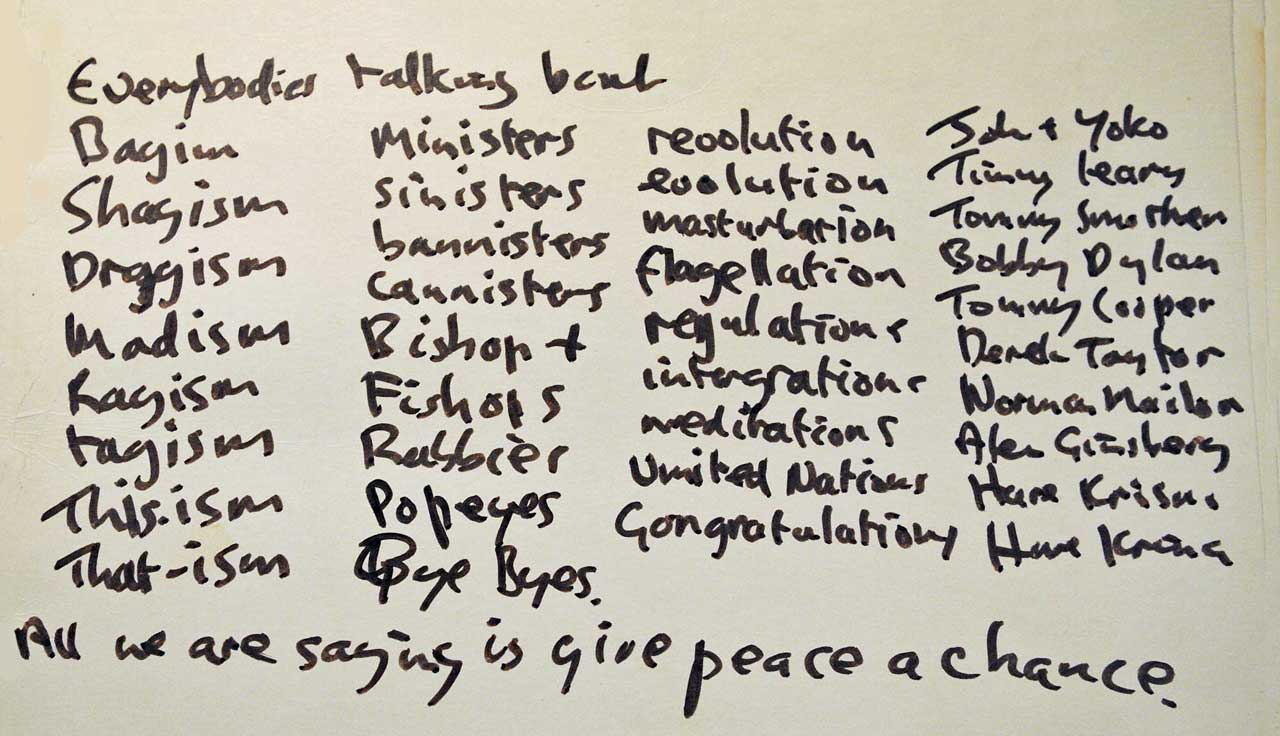
On June 1, 1969, in room 1742 at the Hotel Reine Elizabeth in Montreal, Canada, John Lennon and Yoko Ono made history. Along with an enthusiastic crowd of students, Hare Krishna devotees, and celebrity friends including Timothy Leary and Allen Ginsberg, they recorded the best-known anti-war song of the 20th century.
“In my secret heart, I wanted to write something that would take over We Shall Overcome,” Lennon told David Sheff in 1980. “I don’t know why, that’s the one they always sang.”
Indeed, that rousing folk song, derived from an old gospel hymn, had been around for 70 years before it became emblematic to the Civil Rights movement. Lennon said: “I thought: ‘Why isn’t somebody writing one for people now?’ That’s what my job is.”
For the previous nine years, Lennon’s job had been as a full-time member of The Beatles. And while the Fabs certainly had their socially conscious songwriting moments, especially with All You Need Is Love and Revolution, when John got together with Yoko his focus shifted to straight-on activism against the Vietnam War.
Give Peace A Chance was the culmination of two months of masterful media manipulation. It started at the Amsterdam Hilton. To celebrate their honeymoon, the couple staged a Bed-In (the concept came from Yoko’s days as a performance artist). The press had lurid expectations.
“These guys were sweating to fight to get in first because they thought we were going to make love in bed,” Lennon said. Instead, he and Yoko lounged around in their pyjamas for a week, giving non-stop interviews about their new peace initiative. “We’re trying to sell peace, like a product,” Lennon told reporters, “and sell it like people sell soap or soft drinks.”
When Lennon was criticised by the Daily Mirror as having “gone off his rocker”, he responded: “All we’re trying to do is make you aware that there are other forms of protest. It’s part of our policy not to be taken seriously, because our opposition, whoever they may be, in all their manifest forms, don’t know how to handle humour. We’re willing to be the world’s clowns.”
In Vienna, John and Yoko had staged their ‘Bagism’ event, talking to the press from inside large white sacks. Eliminating visual barriers and preconceived bias made “total communication” possible, according to Lennon.
The next stop was the Bahamas. Although the sweltering heat proved too much for them after a few days, it was there in the Sheraton Hotel that Lennon started writing Give Peace A Chance (a recently unearthed video on YouTube shows him strumming through an early take).
The song title came from an off-the-cuff answer he’d given to a reporter when asked what he and Yoko were trying to achieve by staying in bed. By the time they reached Montreal (Lennon was refused entry to the US because of a conviction in 1968 in the UKfor possession of marijuana), the song had come together. Its simple chorus contrasted with rapid-fire verses – spoken like a proto-rap – about the many obsessions that consume our daily consciousness, from celebrities to sex to social labels. The song basically asked: why not add peace to that list?
In the Montreal hotel room, lyrics were scrawled on huge boards so everyone could sing along. Local recording engineer André Perry captured the spirited onetake performance with four microphones plugged straight into a four-track machine. John then insisted on a lightning quick turnaround of the record. One month later, it hit the shops.
While it climbed to No.22 in the UK and No.14 in the US, its importance went beyond radio play and the charts. In November 1969 the song was sung by half a million demonstrators in Washington, DC at the Vietnam Moratorium Day, with folk singer Pete Seeger leading the charge. After watching the footage on TV, Lennon said: “It was one of the biggest moments of my life.”
Soon it was being sung on college campuses across the country, and has remained part of anti-war rallies around the world ever since. In 1994 it was adopted by the Northern Ireland peace process, with campaigner David Magee getting radio stations and newspapers to use the song as the movement’s slogan. In March 2022, more than 150 European public radio stations broadcast the track simultaneously to protest at Russia’s invasion of Ukraine. And in 2023, newspaper editorials across the world used the title to headline calls for a ceasefire in Palestine.
What makes Give Peace A Chance resonate still is how it presents us with a choice rather than strict dogma.
As Lennon said in 1980: “It wasn’t like ‘You have to have peace!’ Just give it a chance. We ain’t giving any gospel here, just saying how about this version for a change? We think we have the right to have a say in the future. And we think the future is made in your mind.”







